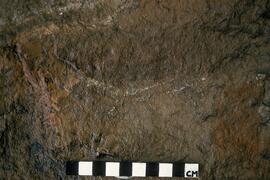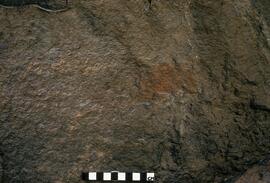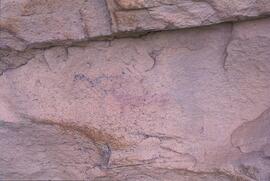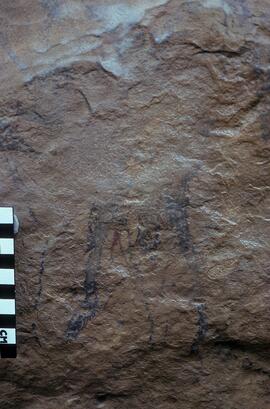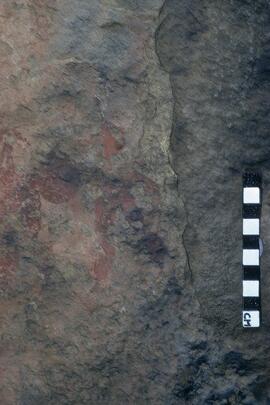Identity area
Reference code
Title
Date(s)
- 11/07/2005 (Creation)
Level of description
Extent and medium
Context area
Name of creator
Biographical history
Name of creator
Biographical history
The ARAL Project Analysis of Rock Art in Lesotho (Project ARAL) was motivated and directed by Professor L.G.A. Smits of the National University of Lesotho. The project was set up to document and analyse the rock paintings of the San people who previously occupied the area of the Maluti and Drakensberg mountains. Funded by the Netherlands Government overseas development agency, and supervised by the Africa Study Centre of the University of Leiden, the project ran a full time programme from 1979 to 1984. Thereafter, work was done on an occasional basis as funds allowed. More than 700 sites were recorded. The main aims of the project were to:
Search intensively in demarcated research areas to locate San paintings, record the paintings systematically using high quality photography and document the sites at which the paintings occurred for additional archaeological information.
Decipher and analyse the paintings from the photographic record.
The photographic recording, fieldwork and deciphering methodology was described in a paper delivered to the South African Archaeology Association annual conference in 1983, and further discussed at a special rock art workshop convened by the same body later that year.
Technology and the recording methodology
The best photographic equipment and film available at the time were used for the project, and the methodology aimed to create a systematic and uniform record of the sites recorded, both in terms of organisation of the material, and the consistency of the image exposure, colour and magnification.
Duplication of the master collection was not possible at the completion of the main project due to lack of funds. However, the slide collection has been stored in archival conditions in the Netherlands, and the film used is thought to be capable of storage with no perceptible deterioration for decades under these conditions.
Digital technology for image processing and storage was only at an early stage of development in 1984, and although investigated as a possible means of duplicating the master collection at the time, was found to be both inadequate for rendering the slides into a useful digital form, and enormously expensive.
With the advance of digital imaging technology, and the funding made available through SARADA, it has now been possible to digitise the entire ARAL Collection, as well as Prof. Smits private collection (images taken over a period of 40 years in many parts of Africa, Europe, North America and Australia), both of which are now housed with RARI.
ARAL team.
Lucas Smits: Director, project founder and rock art researcher.
Patricia Bardill-January: Research Officer, responsible for the deciphering and drawing of site images from the photographic record.
Joe Alfers: Photographer/Field Officer, responsible for recording methodology, site recording and cataloguing slides and field reports.
Taole Tesele: Field Officer, responsible for locating sites, recording site content by sketching, assisting with photographic recording and field work.
Repository
Archival history
Search intensively in demarcated research areas to locate San paintings, record the paintings systematically using high quality photography and document the sites at which the paintings occurred for additional archaeological information.
Decipher and analyse the paintings from the photographic record.
The photographic recording, fieldwork and deciphering methodology was described in a paper delivered to the South African Archaeology Association annual conference in 1983, and further discussed at a special rock art workshop convened by the same body later that year.
Technology and the recording methodology
The best photographic equipment and film available at the time were used for the project, and the methodology aimed to create a systematic and uniform record of the sites recorded, both in terms of organisation of the material, and the consistency of the image exposure, colour and magnification.
Duplication of the master collection was not possible at the completion of the main project due to lack of funds. However, the slide collection has been stored in archival conditions in the Netherlands, and the film used is thought to be capable of storage with no perceptible deterioration for decades under these conditions.
Digital technology for image processing and storage was only at an early stage of development in 1984, and although investigated as a possible means of duplicating the master collection at the time, was found to be both inadequate for rendering the slides into a useful digital form, and enormously expensive.
With the advance of digital imaging technology, and the funding made available through SARADA, it has now been possible to digitise the entire ARAL Collection, as well as Prof. Smits private collection (images taken over a period of 40 years in many parts of Africa, Europe, North America and Australia), both of which are now housed with RARI.
ARAL team.
Lucas Smits: Director, project founder and rock art researcher.
Patricia Bardill-January: Research Officer, responsible for the deciphering and drawing of site images from the photographic record.
Joe Alfers: Photographer/Field Officer, responsible for recording methodology, site recording and cataloguing slides and field reports.
Taole Tesele: Field Officer, responsible for locating sites, recording site content by sketching, assisting with photographic recording and field work.
Immediate source of acquisition or transfer
Content and structure area
Scope and content
Date of aquisition from: 11/07/2005
Date of aquisition to: 11/07/2005
Appraisal, destruction and scheduling
Accruals
System of arrangement
Conditions of access and use area
Conditions governing access
Conditions governing reproduction
Language of material
- English
Script of material
- Latin

